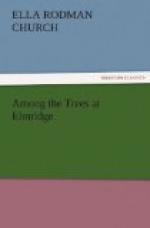“And just the nicest kind of candy, too,” said the children, with one voice.
Their governess smiled, for this was very much her own opinion.
“You do not know,” she continued, “how strangely these nuts grow. They have an outer husk, or rind, which when green is hard and has a very pleasant smell; the tree then seems to be covered with green balls. As the nuts ripen this outer part becomes so dark that it is almost black and grows soft and spongy. A rich brown dye is made from it. Black-walnut wood has long been famous for its beauty, and it grows deeper and darker with age. It is handsomely shaded and takes a fine polish, and this, with its durability, makes it very valuable for furniture. Posts made of it will last a long time, and it can be put to almost any use for which hard-wood is available.
“The walnut tree has a great variety of good qualities in addition to its fine appearance and generous shade. From the kernel a valuable oil may be obtained for use in cookery and in lamps. Bread has also been made from the kernels. The spongy husk of the nuts is used as dyestuff. It thus unites almost all the qualities desirable in a tree—beauty, gracefulness and richness of foliage in every period of its growth; bark and husks which may be employed in an important art; fruit valuable as food; wood unsurpassed in durability and in elegance.”
“I like English walnuts,” said Clara, “they have such thin, pretty shells; and papa, you know, can open them in just two halves with a knife.”
“Once,” said Miss Harson, “I had a little bag sent to me made of two very large walnut shells with blue silk between, and in this bag there was a pair of kid gloves rolled up very tight.”
“Oh!” exclaimed the children. It sounded like a fairy-tale, but they knew that it was true, because Miss Harson said that it had really happened. They were very much surprised, though, that a bag could be made of nutshells, and that a pair of gloves could be crowded into so small a compass.
“Did it come from England?” asked Malcolm.
“No,” replied his governess; “it was sent to me from the island of Madeira, where these nuts grow so abundantly that they have often been called Madeira-nuts. It also grows abundantly in Europe, and the nuts are used for dessert, pickling, and many other purposes, while the poorer classes often depend largely on them for food.”
“Do they eat ’em instead of bread?” asked Edith. “I’d like that; they’re ever so much nicer!”
“Perhaps you would not think so if you had hardly anything else to eat; you would get tired of them then. In many places on the continent of Europe the roads are lined with walnut trees for miles together, and in the proper season the people may feast upon the fruit as much as they like. A person, it is said, once traveled from Florence to Geneva and ate nothing by the way but walnuts; but I must say that I should not like to do it. One species bears a nut as large as an egg; but if kept any time, it will shrink to half its natural size. The shell of this great walnut, we are told, is sometimes used for making little ornamental boxes to hold gloves and small fancy-articles; so you see that mine was not the only glove-bag made of two walnut-shells.”




